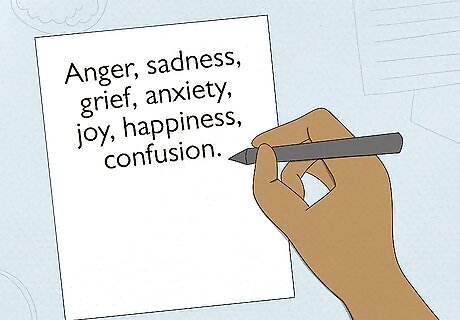
views
Starting the Poem

Write down a list of emotions that you connect with. Start by making a list of emotions that resonate with you or that you have experienced first hand. You may have a short list of emotions or a long one. Let your thoughts flow and write down as many emotions as you can. You may end up with a list that has a wide range of emotions, which is fine. For example, you may write down: “anger, sadness, grief, anxiety, joy, happiness, confusion.”

Choose one emotion and brainstorm ideas. Look over your list of emotions and choose the one that speaks the most to you. Circle it and then use it as a prompt to brainstorm ideas for your poem. You may do a freewrite where you use the emotion as your prompt and write freely, without stopping, for a 10 to 15 minutes. Then, look over your freewrite and pick out lines or phrases that could go into your poem. You could also write about a personal experience where you felt that emotion. For example, maybe you felt angry when you got into a fight with your mother or when you lost an important match or game. Or perhaps you felt grief when you lost a close friend or relative. You may then use this experience as a jumping off point for starting your poem. You may try doing a brain cluster exercise around the emotion where you write down words or phrases that come to mind when you think of the emotion. Place them in clusters on the page around the emotion. You could then use these words or phrases in your poem.

Read examples of emotional poetry. To get more inspiration for your poem, read published poems that discuss a specific emotion. Notice how the poet uses the poem to express their feelings about a specific emotion and to explore different ways to discuss emotion on the page. You may read: “I measure every Grief I meet” by Emily Dickinson “Anger” by April Benard “Facing It” by Yusef Komunyakaa “What Are Years” by Marianne Moore
Writing the Poem

Use sensory detail and concrete images to describe the emotion. Rather than try to simply include the emotion in your poem, challenge yourself to avoid naming the emotion in your writing. Instead, try to describe the emotion using sensory detail, such as how the emotion might smell, taste, sound, feel, or look like. You can also use concrete images to describe the emotion so you can communicate your feelings about the emotion to your reader. Ask yourself, “If the emotion were a color, what color would it be?” and “What does the color smell like? Taste like? Sound like? Feel like? Look like?” For example, if you were writing about anger, you may write: “Anger is red. It smells like burnt toast. It tastes like dry mouth. It sounds like a siren. It feels like a slap in the face. It looks like a cluster of red ants.”

Write about the emotion using a particular experience. Focus on a specific experience or moment where you felt the emotion and write about it in your poem. Think about an experience where you were overcome by this particular moment or an event that caused you to feel the emotion. For example, if you are writing about grief, you may focus on the experience of sitting at the deathbed of a loved one. You may describe the experience with sensory detail and concrete images to communicate the emotion you felt during the experience.

Use literary devices. To make your poem stronger, you should use literary devices throughout. Literary devices like metaphor and simile will make your writing more succinct and unique. They also allow you to create images that linger in the reader’s mind and help to get the experience of the emotion across to your reader. A simile uses “like” or “as” to compare one thing to another. For example, “My anger is like a pot bubbling over on the stove.” A metaphor compares one thing to another without using “like” or “as.” For example, “My anger is a hive of bees in the backyard.”

Personify the emotion. You can also write an emotional poem by personifying the emotion on the page. To personify an emotion, ask yourself, “If this emotion were a person, what would it do?” This way, you can use strong active verbs to describe the emotion and give it life on the page. You may try making a list of verbs that you think relate to the emotion or speak to how the emotion might express itself. For example, if you were writing about anger, you may write down verbs like “screams, flumes, explodes, yells, shouts.” You may personify anger by writing: “Anger flumes at other. Anger screams when it doesn’t get its way. Anger explodes at the first sign of weakness.”
Polishing the Poem

Revise the poem. Once you have a draft of the poem, you should sit down and read it out loud. Listen to how each line sounds as well as each word in the poem. Notice if the poem flows well or sounds awkward or confusing in some places. Underline or highlight any areas that need to be revised. Then, go in and revise the poem until it is at its best. You can also revise the poem by reading it to someone else and getting feedback from them. Be open to constructive criticism as it will only strengthen your poem.

Submit the poem to a publication. If you feel your poem is polished and strong, you may want to share it with others. Submit the poem to publications online, such as poetry websites or magazines. You can also send the poem by mail to magazines and publications to see if it gets published. You may search online for publications that have a call for poems on a specific emotion or are putting on a contests for the best poetry about an emotion. Your poem may be more likely to get published if it applies to a specific prompt or theme that a publication is looking for.

Keep the poem for yourself. If you feel the poem is too emotional and personal to share with others, you may keep it for yourself. Put the poem in a journal or a private folder on your computer so you can look at it when you want to. You may revise it over time and feel ready to share it with others at some point or decide to keep it to yourself. Sometimes poetry can act as a form of therapy and help you process intense emotions you may be experiencing. You do not need to feel pressure to share your emotional poetry if you are writing it only for yourself and your own enjoyment.














Comments
0 comment